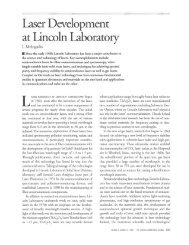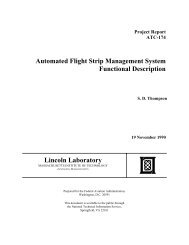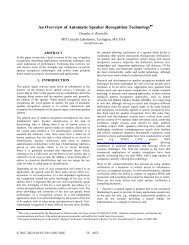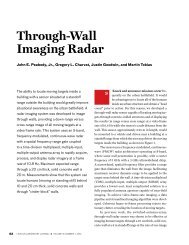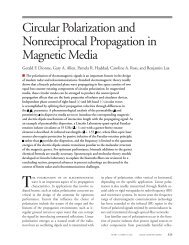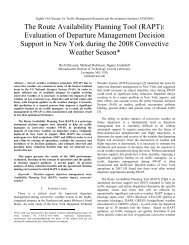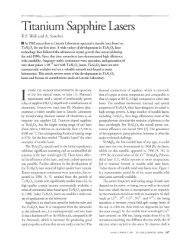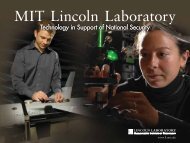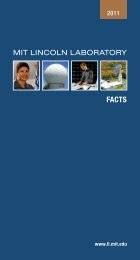2011 Annual Report - MIT Lincoln Laboratory
2011 Annual Report - MIT Lincoln Laboratory
2011 Annual Report - MIT Lincoln Laboratory
Create successful ePaper yourself
Turn your PDF publications into a flip-book with our unique Google optimized e-Paper software.
technology investments<br />
Basic and Applied Research<br />
The <strong>2011</strong> technical investments serve to ensure the rapid transfer of basic and applied research<br />
into the defense applications of the <strong>Laboratory</strong>’s sponsors and to strengthen interactions with the<br />
<strong>Laboratory</strong>’s academic partners.<br />
Signal Processing for Graphs<br />
The ability to identify interesting groups and<br />
group behaviors in a wide range of networks<br />
is of growing interest to the Department of<br />
Defense (DoD) and intelligence community.<br />
<strong>Lincoln</strong> <strong>Laboratory</strong> staff and a Harvard<br />
University professor are addressing this<br />
difficult problem by using statistical detection<br />
theory that has traditionally been applied to<br />
signals and images. The results achieved so<br />
far show that the emerging techniques can<br />
detect subtle group formations and behaviors<br />
in the presence of noisy and very large<br />
background graphs or networks. The<br />
<strong>Laboratory</strong> is looking to apply these<br />
techniques to identify threat networks<br />
in large social networks or to discover<br />
staging sites from vehicle tracking data.<br />
Imaging into Obscured Areas<br />
<strong>Lincoln</strong> <strong>Laboratory</strong> staff and the <strong>MIT</strong> Media<br />
Lab are working to demonstrate laser imaging<br />
around corners and into rooms or areas. The<br />
Media Lab has developed the theoretical basis<br />
for the image reconstruction for this technique.<br />
Their reconstruction algorithms demonstrated novel<br />
properties and were applied to simulated data and<br />
laboratory measurements over short distances. The<br />
<strong>Laboratory</strong> is looking to apply this research to DoD<br />
missions because it may offer significant capability in<br />
support of urban and Special Forces operations.<br />
Liquid Crystal Thermal Imager<br />
Uncooled thermal detectors have become an indispensible<br />
sensor technology in military long-wave<br />
infrared (LWIR) imaging applications. The <strong>Laboratory</strong><br />
is developing a detector that uses sensitive liquid<br />
crystals to detect small changes in temperature<br />
created by an infrared image. This novel approach<br />
combines the liquid crystal detection with readout<br />
of the image by using a low-cost, solid-state imager<br />
(charge-coupled device or CMOS active pixel sensor).<br />
Separating the infrared-to-visible conversion process<br />
from the electronic readout enables independent<br />
optimization of components for greater performance<br />
at lower costs.<br />
12 <strong>2011</strong> <strong>Annual</strong> <strong>Report</strong><br />
Quantum Cascade Lasers<br />
In collaboration with Harvard University, <strong>Lincoln</strong><br />
<strong>Laboratory</strong> has been developing advanced quantum<br />
cascade laser (QCL) technology for potential use in<br />
a variety of DoD applications. In particular, compact<br />
arrays of individually addressable (wavelength<br />
selectable), watt-class, LWIR semiconductor laser<br />
sources would have great utility as rapidly tunable<br />
optical sources in spectroscopy-based chemical and<br />
biological detection systems. The technical effort at<br />
<strong>Lincoln</strong> <strong>Laboratory</strong> has focused on the challenging<br />
epitaxial growth of high-performance QCL device<br />
structures, individual QCL device fabrication, and<br />
integration of QCL arrays into wavelength-beamcombined<br />
system demonstrations.<br />
Novel graph algorithm<br />
techniques enable<br />
detection of anomalous<br />
patterns in network<br />
traffic.



